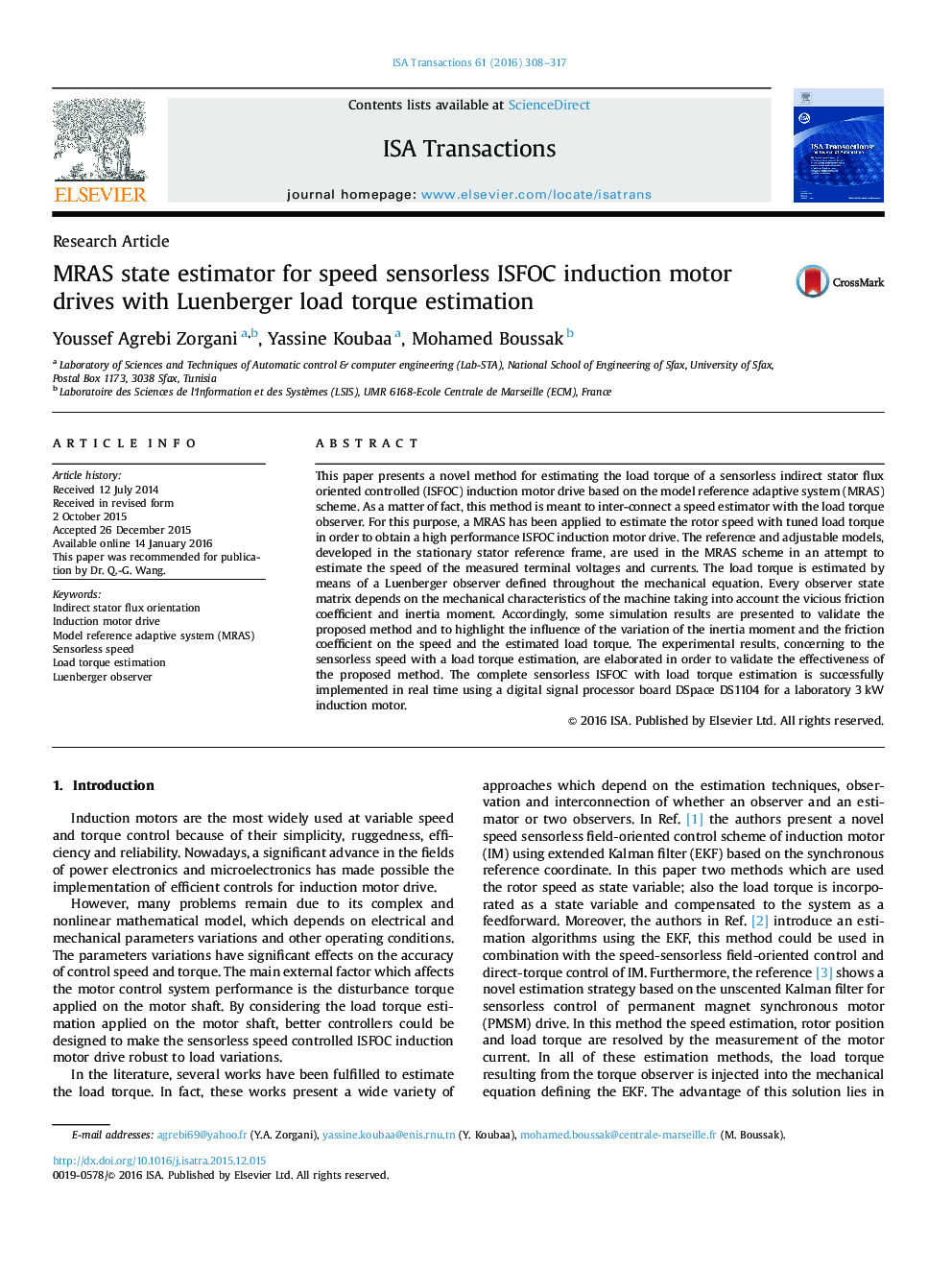| کد مقاله | کد نشریه | سال انتشار | مقاله انگلیسی | نسخه تمام متن |
|---|---|---|---|---|
| 5004219 | 1461194 | 2016 | 10 صفحه PDF | دانلود رایگان |
کلمات کلیدی
1. مقدمه
فهرست علایم
2. تخمین سرعت رتور مبتنی بر MRAS
شکل 1. ساختار ارزیابی با روش تطبیق پذیر با مدل مرجع
شکل 2. ایجاد تصحیح کننده سرعت
3. تخمین گشتاور بار
شکل 3. ساختار گشتاور بار تخمین زده شده توسط مشاهده گر لوئن برگر
جدول 1. تاثیر ثابت اینرسی بر روی گشتاور بار
جدول 2. پارامترهای موتور القایی
شکل 4. کنترلر ماشین آسنکرون بدون یک حسگر مکانیکی با تخمین گشتاور بار توسط مشاهده گر لوئن برگر
3.1 تاثیر تغییر ممان اینرسی روی گشتاور بار
3.2 تاثیر ضریب اصطکاک بر روی تخمین گشتاور بار
شکل 5. نتایج شبیه سازی برای سرعت مرجع (0-1000 rpm) با گشتاور بار اعمال شده و جدا شده در ثانیه های t=4 و t=11
شکل 6. تاثیر تغییر ممان اینرسی بر روی سرعت چرخشی و گشتاور بار
4. نتایج شبیه سازی
شکل 7. بلوک دیاگرام سیستم درایو ISFOC با مشاهده گر سرعت رتور و گشتاور بار
شکل 8. نتایج آزمایشگاهی کنترل بدون حسگر تحت گشتاور بار با ممان اینرسی برابر با 50% مقدار نامی
5. نتایج آزمایشگاهی
شکل 9. نتایج آزمایشگاهی کنترل بدون حسگر تحت گشتاور بار با ممان اینرسی برابر با 100% مقدار نامی
شکل 10. نتایج آزمایشگاهی کنترل بدون حسگر تحت گشتاور بار با ممان اینرسی برابر با 200% مقدار نامی
6. نتیجه گیری
- We present a method of estimating the speed and the load torque without a mechanical sensor
- The reference and adjustable models are developed in the stator reference frame.
- The torque is assessed by means of a Luenberger observer defined by the mechanical equation.
- Simulation results are presented to validate the suggested method
- Experimental results are elaborated in order to validate the proposed method.
This paper presents a novel method for estimating the load torque of a sensorless indirect stator flux oriented controlled (ISFOC) induction motor drive based on the model reference adaptive system (MRAS) scheme. As a matter of fact, this method is meant to inter-connect a speed estimator with the load torque observer. For this purpose, a MRAS has been applied to estimate the rotor speed with tuned load torque in order to obtain a high performance ISFOC induction motor drive. The reference and adjustable models, developed in the stationary stator reference frame, are used in the MRAS scheme in an attempt to estimate the speed of the measured terminal voltages and currents. The load torque is estimated by means of a Luenberger observer defined throughout the mechanical equation. Every observer state matrix depends on the mechanical characteristics of the machine taking into account the vicious friction coefficient and inertia moment. Accordingly, some simulation results are presented to validate the proposed method and to highlight the influence of the variation of the inertia moment and the friction coefficient on the speed and the estimated load torque. The experimental results, concerning to the sensorless speed with a load torque estimation, are elaborated in order to validate the effectiveness of the proposed method. The complete sensorless ISFOC with load torque estimation is successfully implemented in real time using a digital signal processor board DSpace DS1104 for a laboratory 3Â kW induction motor.
Journal: ISA Transactions - Volume 61, March 2016, Pages 308-317
